Portfolio optimization: Some aspects of modeling and computing
The paper focuses on computational aspects of portfolio optimization (PO) problems.
The objectives of such problems may include: expectedreturn, standard deviation and variation
coefficient of the portfolioreturn rate. PO problems can be formulated as mathematical
programming problems in crisp, stochastic or fuzzy environments. To compute optimal solutions
of such single- and multi-objective programming problems, the paper proposes the use of a
computational optimization method such as RST2ANU method, which can be applied for nonconvex programming problems. Especially, an updated version of the interactive fuzzy utility
method, named UIFUM, is proposed to deal with portfolio multi-objective optimization problems.
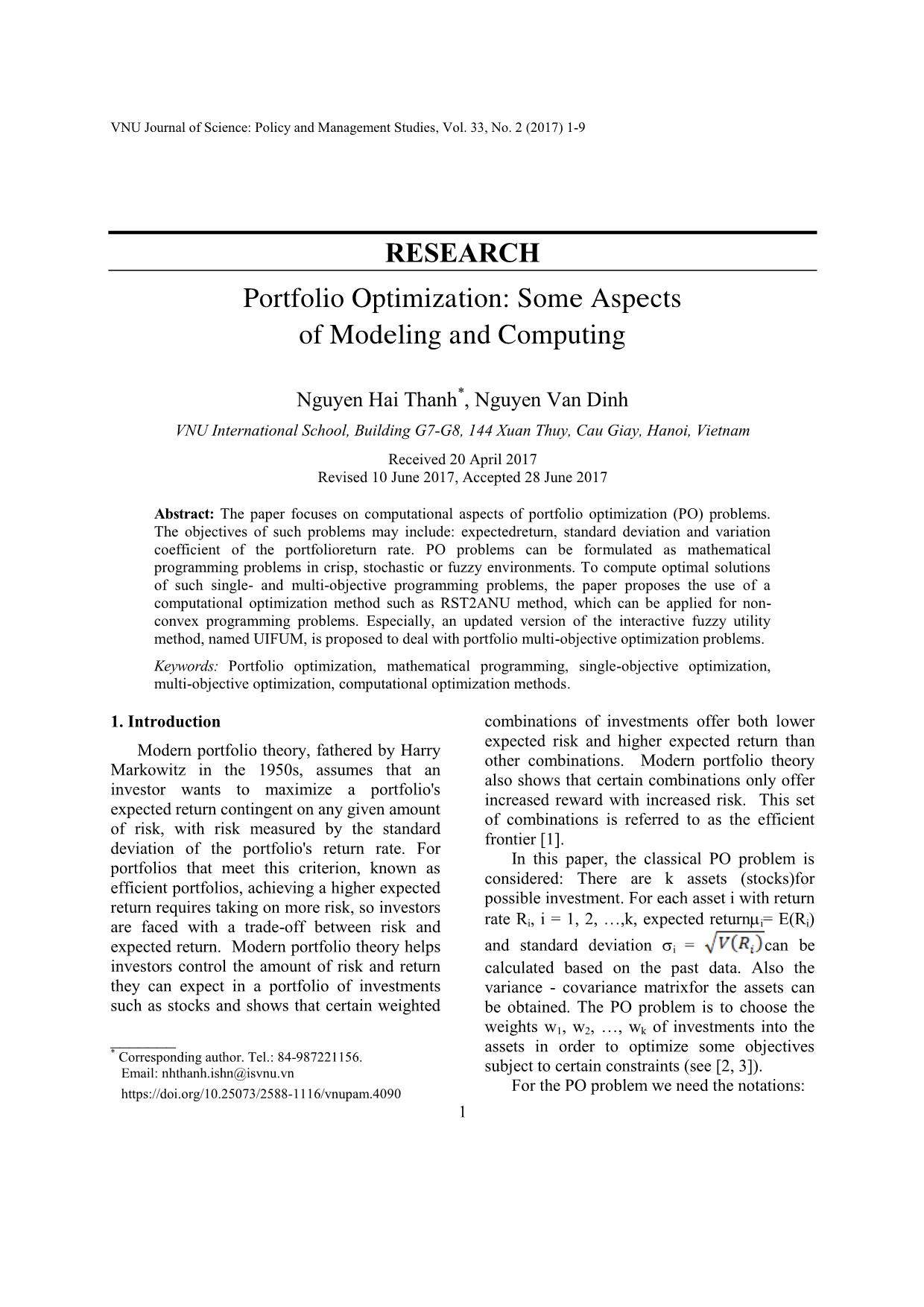
Trang 1
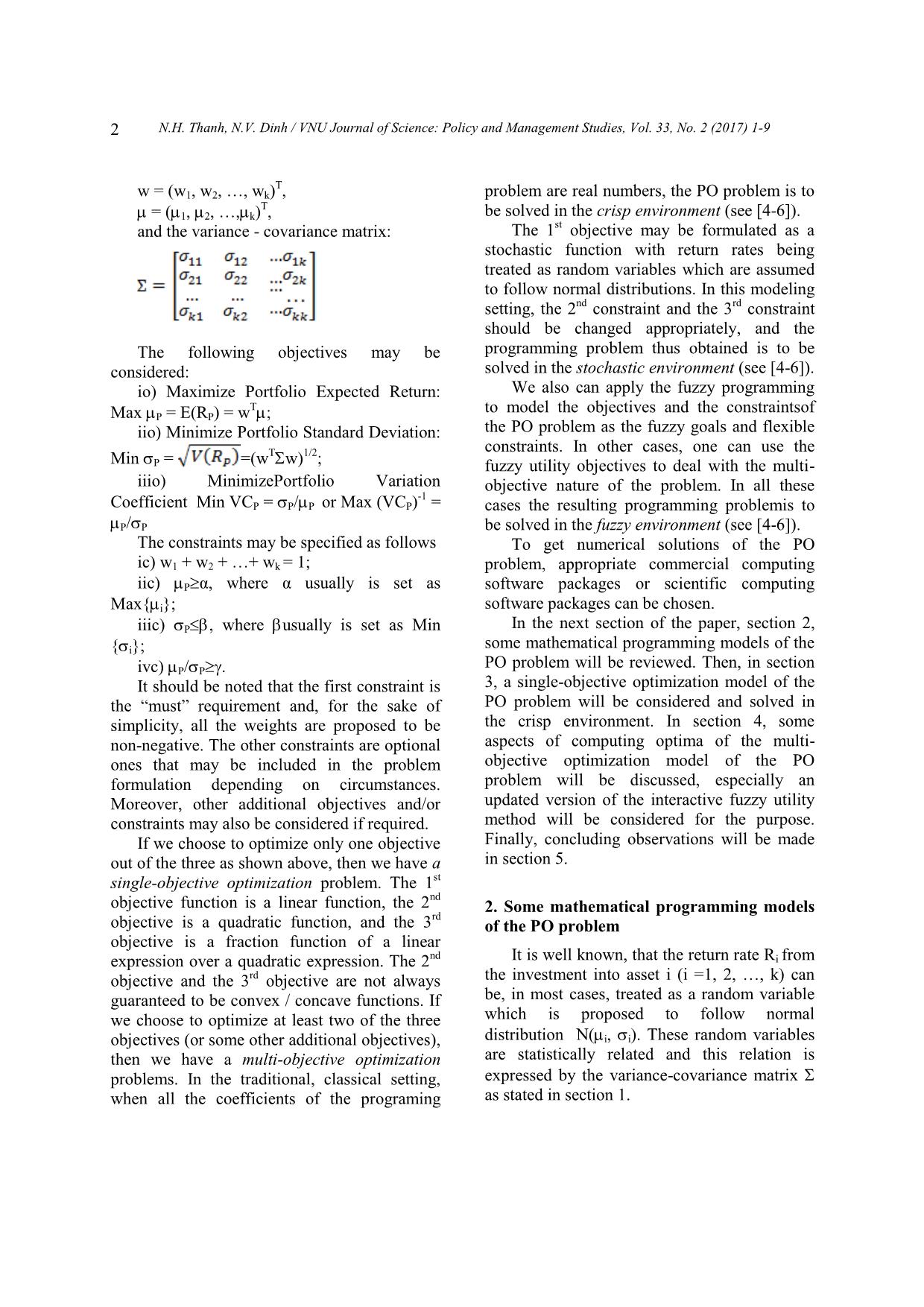
Trang 2
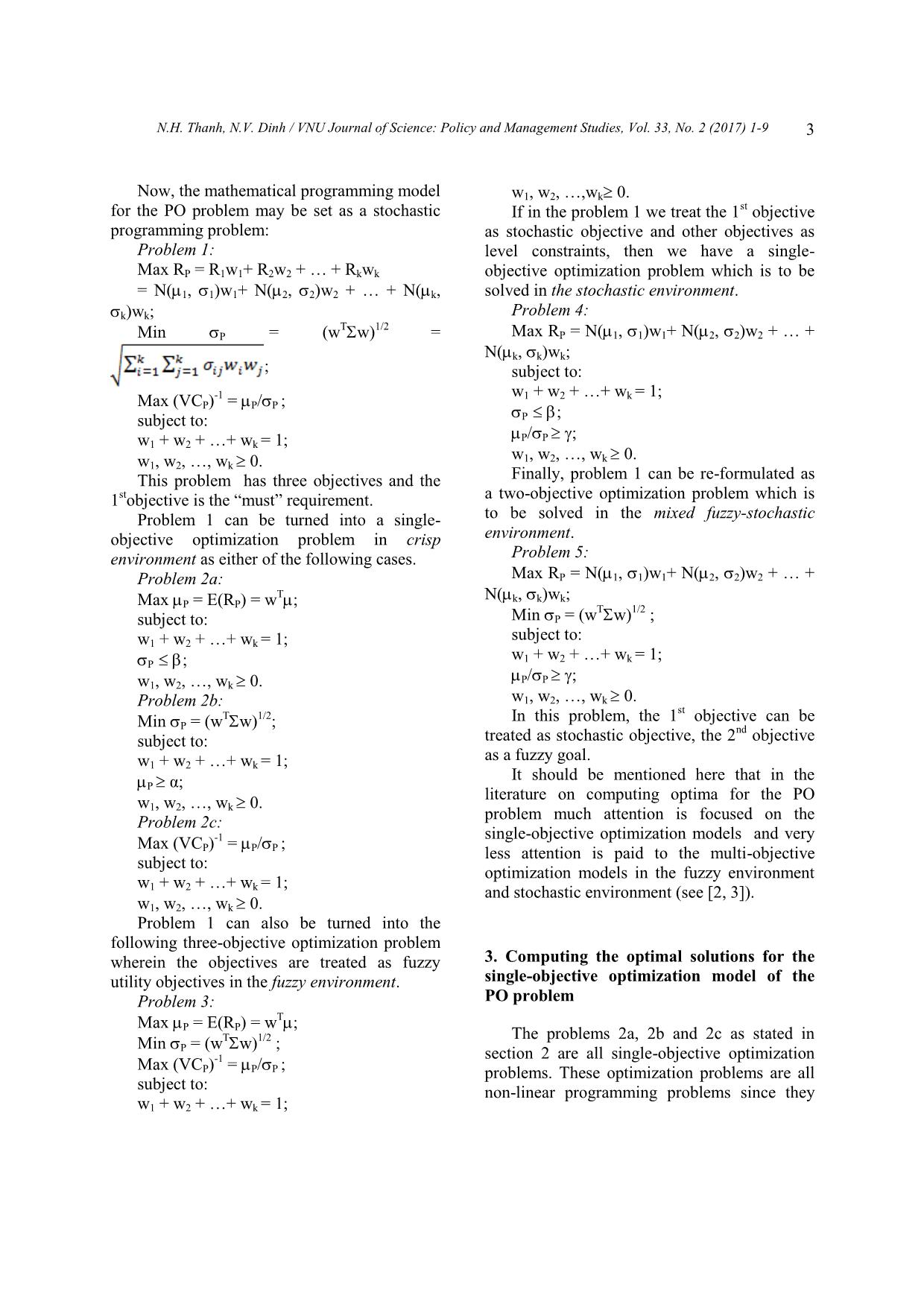
Trang 3
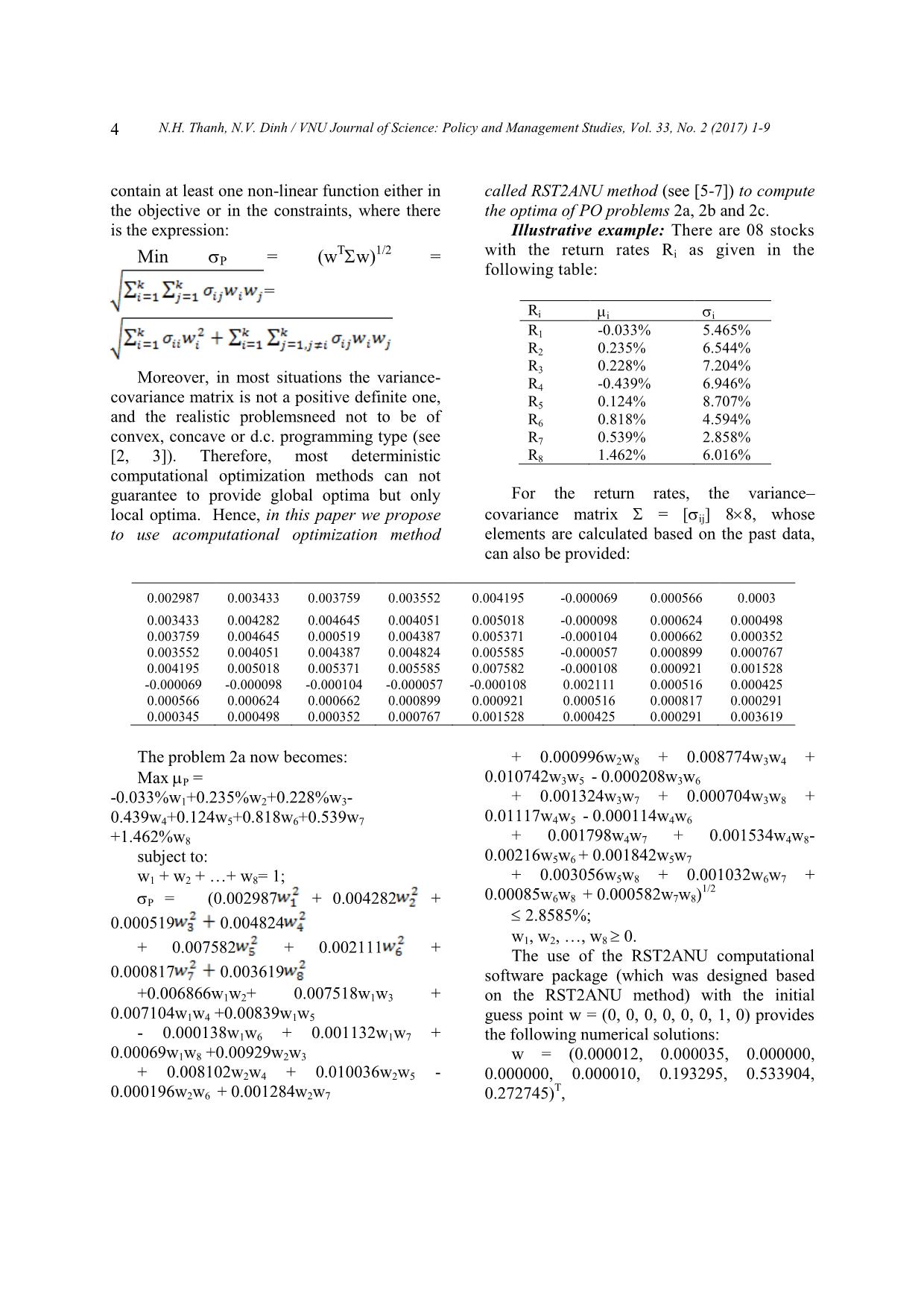
Trang 4
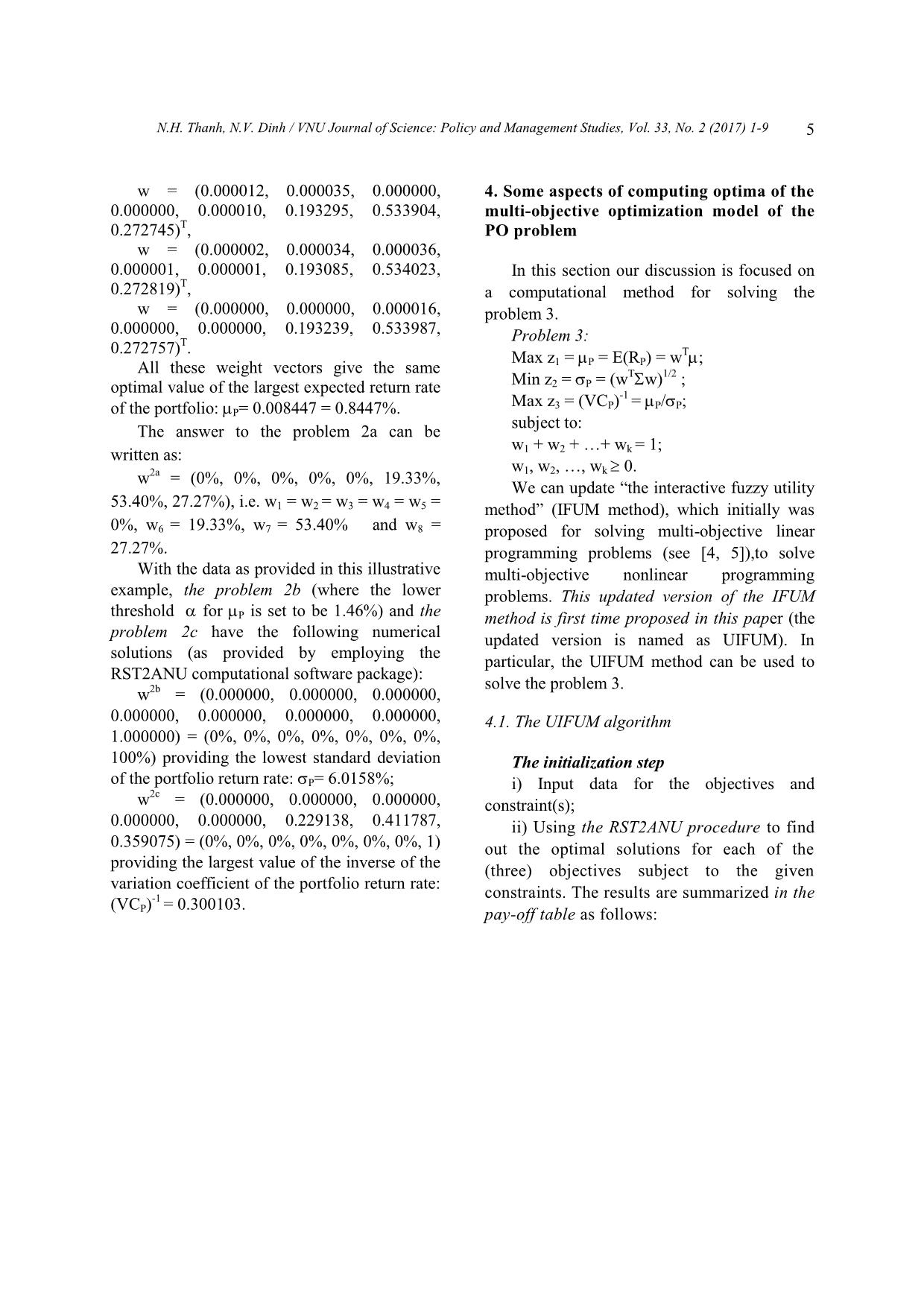
Trang 5

Trang 6
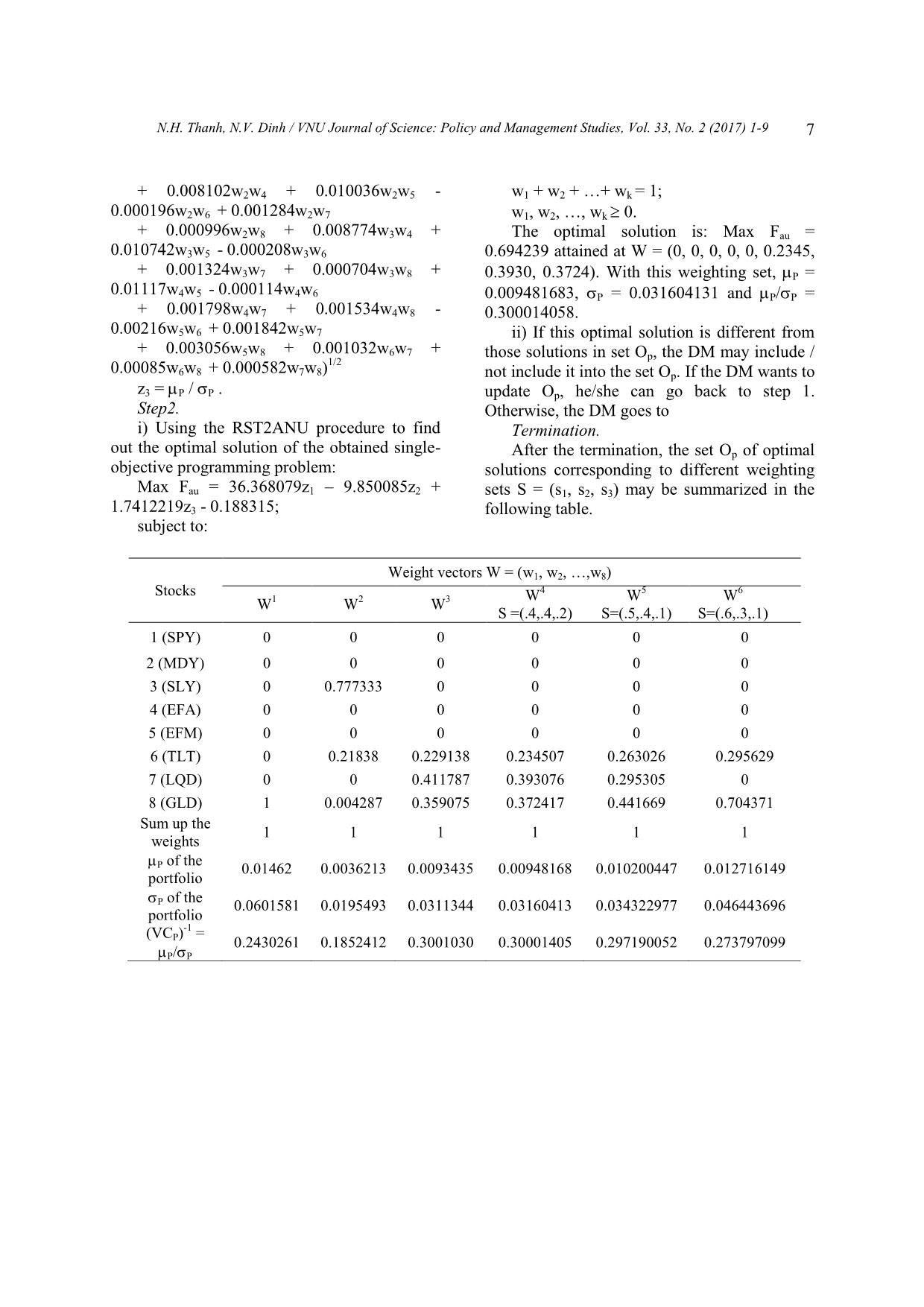
Trang 7
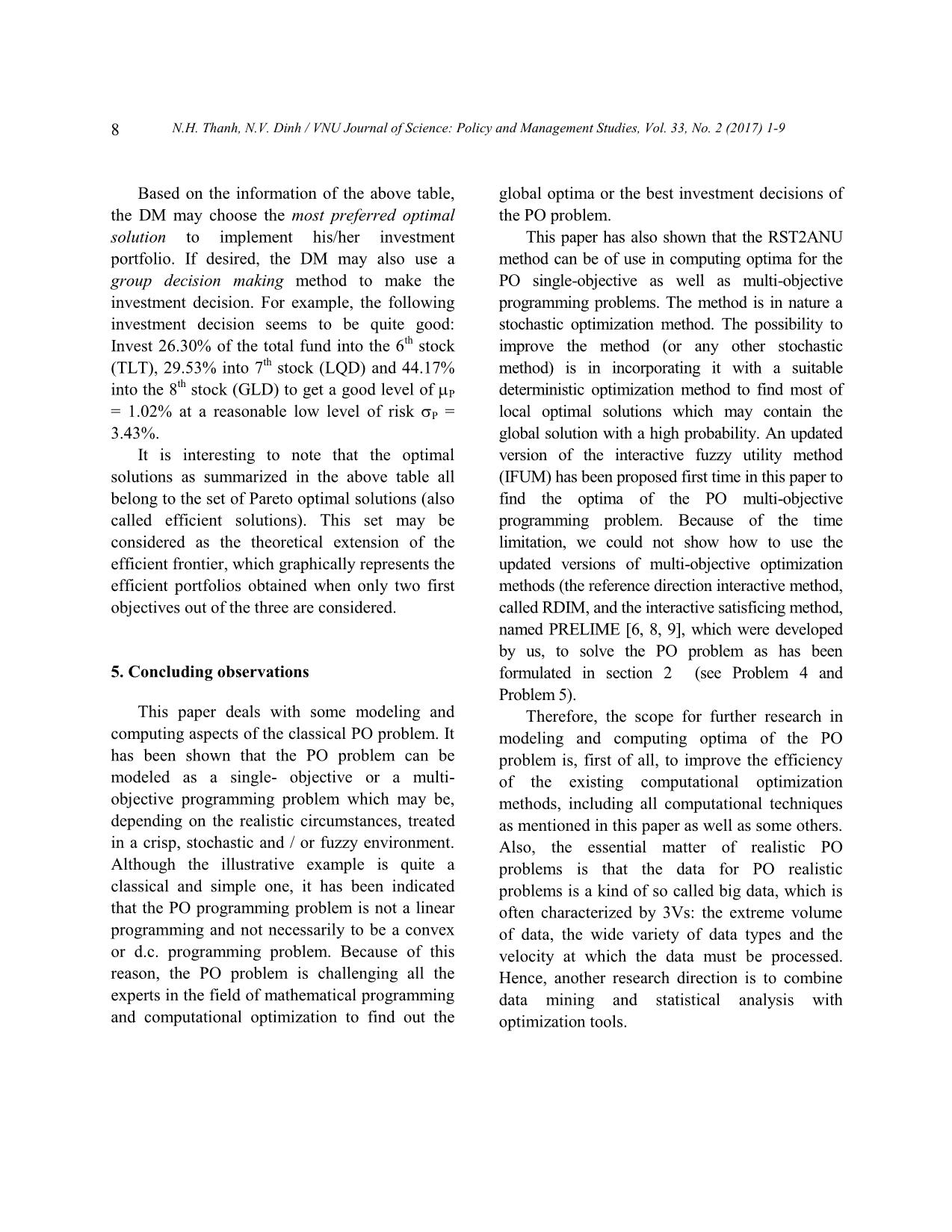
Trang 8

Trang 9
Tóm tắt nội dung tài liệu: Portfolio optimization: Some aspects of modeling and computing
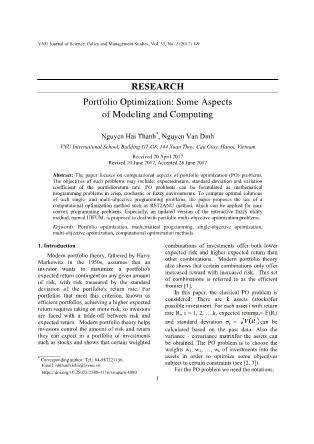
VNU Journal of Science: Policy and Management Studies, Vol. 33, No. 2 (2017) 1-9
1
RESEARCH
Portfolio Optimization: Some Aspects
of Modeling and Computing
Nguyen Hai Thanh*, Nguyen Van Dinh
VNU International School, Building G7-G8, 144 Xuan Thuy, Cau Giay, Hanoi, Vietnam
Received 20 April 2017
Revised 10 June 2017, Accepted 28 June 2017
Abstract: The paper focuses on computational aspects of portfolio optimization (PO) problems.
The objectives of such problems may include: expectedreturn, standard deviation and variation
coefficient of the portfolioreturn rate. PO problems can be formulated as mathematical
programming problems in crisp, stochastic or fuzzy environments. To compute optimal solutions
of such single- and multi-objective programming problems, the paper proposes the use of a
computational optimization method such as RST2ANU method, which can be applied for non-
convex programming problems. Especially, an updated version of the interactive fuzzy utility
method, named UIFUM, is proposed to deal with portfolio multi-objective optimization problems.
Keywords: Portfolio optimization, mathematical programming, single-objective optimization,
multi-objective optimization, computational optimization methods.
1. Introduction
*
Modern portfolio theory, fathered by Harry
Markowitz in the 1950s, assumes that an
investor wants to maximize a portfolio's
expected return contingent on any given amount
of risk, with risk measured by the standard
deviation of the portfolio's return rate. For
portfolios that meet this criterion, known as
efficient portfolios, achieving a higher expected
return requires taking on more risk, so investors
are faced with a trade-off between risk and
expected return. Modern portfolio theory helps
investors control the amount of risk and return
they can expect in a portfolio of investments
such as stocks and shows that certain weighted
_______
* Corresponding author. Tel.: 84-987221156.
Email: nhthanh.ishn@isvnu.vn
https://doi.org/10.25073/2588-1116/vnupam.4090
combinations of investments offer both lower
expected risk and higher expected return than
other combinations. Modern portfolio theory
also shows that certain combinations only offer
increased reward with increased risk. This set
of combinations is referred to as the efficient
frontier [1].
In this paper, the classical PO problem is
considered: There are k assets (stocks)for
possible investment. For each asset i with return
rate Ri, i = 1, 2, ,k, expected returni= E(Ri)
and standard deviation i = can be
calculated based on the past data. Also the
variance - covariance matrixfor the assets can
be obtained. The PO problem is to choose the
weights w1, w2, , wk of investments into the
assets in order to optimize some objectives
subject to certain constraints (see [2, 3]).
For the PO problem we need the notations:
N.H. Thanh, N.V. Dinh / VNU Journal of Science: Policy and Management Studies, Vol. 33, No. 2 (2017) 1-9
2
w = (w1, w2, , wk)
T
,
= (1, 2, ,k)
T
,
and the variance - covariance matrix:
The following objectives may be
considered:
io) Maximize Portfolio Expected Return:
Max P = E(RP) = w
T;
iio) Minimize Portfolio Standard Deviation:
Min P = =(w
Tw)1/2;
iiio) MinimizePortfolio Variation
Coefficient Min VCP = P/P or Max (VCP)
-1
=
P/P
The constraints may be specified as follows
ic) w1 + w2 + + wk = 1;
iic) P α, where α usually is set as
Max{i};
iiic) P , where usually is set as Min
{i};
ivc) P/P .
It should be noted that the first constraint is
the “must” requirement and, for the sake of
simplicity, all the weights are proposed to be
non-negative. The other constraints are optional
ones that may be included in the problem
formulation depending on circumstances.
Moreover, other additional objectives and/or
constraints may also be considered if required.
If we choose to optimize only one objective
out of the three as shown above, then we have a
single-objective optimization problem. The 1
st
objective function is a linear function, the 2
nd
objective is a quadratic function, and the 3
rd
objective is a fraction function of a linear
expression over a quadratic expression. The 2
nd
objective and the 3
rd
objective are not always
guaranteed to be convex / concave functions. If
we choose to optimize at least two of the three
objectives (or some other additional objectives),
then we have a multi-objective optimization
problems. In the traditional, classical setting,
when all the coefficients of the programing
problem are real numbers, the PO problem is to
be solved in the crisp environment (see [4-6]).
The 1
st
objective may be formulated as a
stochastic function with return rates being
treated as random variables which are assumed
to follow normal distributions. In this modeling
setti ... 2 (2017) 1-9
4
contain at least one non-linear function either in
the objective or in the constraints, where there
is the expression:
Min P = (w
Tw)1/2 =
=
Moreover, in most situations the variance-
covariance matrix is not a positive definite one,
and the realistic problemsneed not to be of
convex, concave or d.c. programming type (see
[2, 3]). Therefore, most deterministic
computational optimization methods can not
guarantee to provide global optima but only
local optima. Hence, in this paper we propose
to use acomputational optimization method
called RST2ANU method (see [5-7]) to compute
the optima of PO problems 2a, 2b and 2c.
Illustrative example: There are 08 stocks
with the return rates Ri as given in the
following table:
Ri i i
R1 -0.033% 5.465%
R2 0.235% 6.544%
R3 0.228% 7.204%
R4 -0.439% 6.946%
R5 0.124% 8.707%
R6 0.818% 4.594%
R7 0.539% 2.858%
R8 1.462% 6.016%
For the return rates, the variance–
covariance matrix = [ij] 8 8, whose
elements are calculated based on the past data,
can also be provided:
f
0.002987 0.003433 0.003759 0.003552 0.004195 -0.000069 0.000566 0.0003
0.003433 0.004282 0.004645 0.004051 0.005018 -0.000098 0.000624 0.000498
0.003759 0.004645 0.000519 0.004387 0.005371 -0.000104 0.000662 0.000352
0.003552 0.004051 0.004387 0.004824 0.005585 -0.000057 0.000899 0.000767
0.004195 0.005018 0.005371 0.005585 0.007582 -0.000108 0.000921 0.001528
-0.000069 -0.000098 -0.000104 -0.000057 -0.000108 0.002111 0.000516 0.000425
0.000566 0.000624 0.000662 0.000899 0.000921 0.000516 0.000817 0.000291
0.000345 0.000498 0.000352 0.000767 0.001528 0.000425 0.000291 0.003619
g
The problem 2a now becomes:
Max P =
-0.033%w1+0.235%w2+0.228%w3-
0.439w4+0.124w5+0.818w6+0.539w7
+1.462%w8
subject to:
w1 + w2 + + w8= 1;
P = (0.002987 + 0.004282 +
0.000519 0.004824
+ 0.007582 + 0.002111 +
0.000817 0.003619
+0.006866w1w2+ 0.007518w1w3 +
0.007104w1w4 +0.00839w1w5
- 0.000138w1w6 + 0.001132w1w7 +
0.00069w1w8 +0.00929w2w3
+ 0.008102w2w4 + 0.010036w2w5 -
0.000196w2w6 + 0.001284w2w7
+ 0.000996w2w8 + 0.008774w3w4 +
0.010742w3w5 - 0.000208w3w6
+ 0.001324w3w7 + 0.000704w3w8 +
0.01117w4w5 - 0.000114w4w6
+ 0.001798w4w7 + 0.001534w4w8-
0.00216w5w6 + 0.001842w5w7
+ 0.003056w5w8 + 0.001032w6w7 +
0.00085w6w8 + 0.000582w7w8)
1/2
2.8585%;
w1, w2, , w8 0.
The use of the RST2ANU computational
software package (which was designed based
on the RST2ANU method) with the initial
guess point w = (0, 0, 0, 0, 0, 0, 1, 0) provides
the following numerical solutions:
w = (0.000012, 0.000035, 0.000000,
0.000000, 0.000010, 0.193295, 0.533904,
0.272745)
T
,
N.H. Thanh, N.V. Dinh / VNU Journal of Science: Policy and Management Studies, Vol. 33, No. 2 (2017) 1-9 5
w = (0.000012, 0.000035, 0.000000,
0.000000, 0.000010, 0.193295, 0.533904,
0.272745)
T
,
w = (0.000002, 0.000034, 0.000036,
0.000001, 0.000001, 0.193085, 0.534023,
0.272819)
T
,
w = (0.000000, 0.000000, 0.000016,
0.000000, 0.000000, 0.193239, 0.533987,
0.272757)
T
.
All these weight vectors give the same
optimal value of the largest expected return rate
of the portfolio: P= 0.008447 = 0.8447%.
The answer to the problem 2a can be
written as:
w
2a
= (0%, 0%, 0%, 0%, 0%, 19.33%,
53.40%, 27.27%), i.e. w1 = w2 = w3 = w4 = w5 =
0%, w6 = 19.33%, w7 = 53.40% and w8 =
27.27%.
With the data as provided in this illustrative
example, the problem 2b (where the lower
threshold for P is set to be 1.46%) and the
problem 2c have the following numerical
solutions (as provided by employing the
RST2ANU computational software package):
w
2b
= (0.000000, 0.000000, 0.000000,
0.000000, 0.000000, 0.000000, 0.000000,
1.000000) = (0%, 0%, 0%, 0%, 0%, 0%, 0%,
100%) providing the lowest standard deviation
of the portfolio return rate: P= 6.0158%;
w
2c
= (0.000000, 0.000000, 0.000000,
0.000000, 0.000000, 0.229138, 0.411787,
0.359075) = (0%, 0%, 0%, 0%, 0%, 0%, 0%, 1)
providing the largest value of the inverse of the
variation coefficient of the portfolio return rate:
(VCP)
-1
= 0.300103.
4. Some aspects of computing optima of the
multi-objective optimization model of the
PO problem
In this section our discussion is focused on
a computational method for solving the
problem 3.
Problem 3:
Max z1 = P = E(RP) = w
T;
Min z2 = P = (w
Tw)1/2 ;
Max z3 = (VCP)
-1
= P/P;
subject to:
w1 + w2 + + wk = 1;
w1, w2, , wk 0.
We can update “the interactive fuzzy utility
method” (IFUM method), which initially was
proposed for solving multi-objective linear
programming problems (see [4, 5]),to solve
multi-objective nonlinear programming
problems. This updated version of the IFUM
method is first time proposed in this paper (the
updated version is named as UIFUM). In
particular, the UIFUM method can be used to
solve the problem 3.
4.1. The UIFUM algorithm
The initialization step
i) Input data for the objectives and
constraint(s);
ii) Using the RST2ANU procedure to find
out the optimal solutions for each of the
(three) objectives subject to the given
constraints. The results are summarized in the
pay-off table as follows:
f
N.H. Thanh, N.V. Dinh / VNU Journal of Science: Policy and Management Studies, Vol. 33, No. 2 (2017) 1-9
6
wherein W
1
, W
2
and W
3
are the optimal
solutions of the (three) single-objective
optimization problems, respectively.
iii) Based on the pay-off information,
formulate the fuzzy utility functions for the
(three) objectives:
fu(z1) =
w
1 1 1
w
1 1
0.00362
0.01462 0.00362B
z z z
z z
90.920196z1 – 0.329253;
fu(z2) = 2 2 2
2 2
0.06016
0.001955 0.06016
w
B w
z z z
z z
-24.625213z2 + 1.481407;
fu(z3) = 3 3 3
3 3
0.18524
0.30010 0.18524
w
B w
z z z
z z
8.706110z3 + 1.612730 .
iv) The initial set of optimal solutions of the
problem 3 is Op = {W
1
, W
2
, W
3
} containing
(weak Pareto) optimal solutions.
Iteration steps
Step1.
i) Specify positive values s1, s2, s3 for weights
of the fuzzy utility functions which are chosen by
the decision maker (DM) depending on his/her
subjective judgment. These weights should satisfy
condition: s1 + s2 + s3 = 1. For example, one may
choose s1 = 0.4, s2 = 0.4, s3 = 0.2 (one can use
notation S = (s1, s2, s3) = (.4, .4, .2).
ii) Construct the aggregation utility
objective function based on the values of the
weights as specified above:
Fau = s1fu(z1) + s2fu(z2) + s3fu(z3)
Fau = 0.4fu(z1) + 0.4fu(z2) + 0.2fu(z3) =
0.4(90.920196z1 – 0.329253)
+ 0.4(-24.625213z2 + 1.481407) +
0.2(8.706110z3- 1.612730)
Fau = 36.368079z1 – 9.850085z2 +
1.7412219z3 - 0.188315,
where
z1 = P = - 0.033%w1 + 0.235%w2 +
0.228%w3 - 0.439w4+ 0.124w5 + 0.818w6 +
0.539w7 +1.462%w8
z2 = P = (0.00297 + 0.004282 +
0.000519 0.004824
+ 0.007582 + 0.002111 +
0.000817 0.003519
+ 0.006866w1w2 + 0.007518w1w3 +
0.007104w1w4 +0.00839w1w5
- 0.000138w1w6 + 0.001132w1w7 +
0.00069w1w8 +0.00929w2w3
Assets (stocks)
Weight vector W = (w1, w2, , w8)
Max Return
Rate
Min Standard
Deviation
Max the Inverse of
Variation Coefficient
W
1
W
2
W
3
1 (SPY) 0 0 0
2 (MDY) 0 0 0
3 (SLY) 0 0.777333 0
4 (EFA) 0 0 0
5 (EFM) 0 0 0
6 (TLT) 0 0.21838 0.229138
7 (LQD) 0 0 0.411787
8 (GLD) 1 0.004287 0.359075
Sum up the weights 1 1 1
P of the portfolio 0.01462 0.00362134 0.009343557
P of the portfolio 0.06015812 0.01954934 0.031134492
(VCP)
-1
= P /P 0.24302619 0.18524122 0.300103091
N.H. Thanh, N.V. Dinh / VNU Journal of Science: Policy and Management Studies, Vol. 33, No. 2 (2017) 1-9 7
+ 0.008102w2w4 + 0.010036w2w5 -
0.000196w2w6 + 0.001284w2w7
+ 0.000996w2w8 + 0.008774w3w4 +
0.010742w3w5 - 0.000208w3w6
+ 0.001324w3w7 + 0.000704w3w8 +
0.01117w4w5 - 0.000114w4w6
+ 0.001798w4w7 + 0.001534w4w8 -
0.00216w5w6 + 0.001842w5w7
+ 0.003056w5w8 + 0.001032w6w7 +
0.00085w6w8 + 0.000582w7w8)
1/2
z3 = P / P .
Step2.
i) Using the RST2ANU procedure to find
out the optimal solution of the obtained single-
objective programming problem:
Max Fau = 36.368079z1 – 9.850085z2 +
1.7412219z3 - 0.188315;
subject to:
w1 + w2 + + wk = 1;
w1, w2, , wk 0.
The optimal solution is: Max Fau =
0.694239 attained at W = (0, 0, 0, 0, 0, 0.2345,
0.3930, 0.3724). With this weighting set, P =
0.009481683, P = 0.031604131 and P/P =
0.300014058.
ii) If this optimal solution is different from
those solutions in set Op, the DM may include /
not include it into the set Op. If the DM wants to
update Op, he/she can go back to step 1.
Otherwise, the DM goes to
Termination.
After the termination, the set Op of optimal
solutions corresponding to different weighting
sets S = (s1, s2, s3) may be summarized in the
following table.
D
r
Stocks
Weight vectors W = (w1, w2, ,w8)
W
1
W
2
W
3
W
4
S =(.4,.4,.2)
W
5
S=(.5,.4,.1)
W
6
S=(.6,.3,.1)
1 (SPY) 0 0 0 0 0 0
2 (MDY) 0 0 0 0 0 0
3 (SLY) 0 0.777333 0 0 0 0
4 (EFA) 0 0 0 0 0 0
5 (EFM) 0 0 0 0 0 0
6 (TLT) 0 0.21838 0.229138 0.234507 0.263026 0.295629
7 (LQD) 0 0 0.411787 0.393076 0.295305 0
8 (GLD) 1 0.004287 0.359075 0.372417 0.441669 0.704371
Sum up the
weights
1 1 1 1 1 1
P of the
portfolio
0.01462 0.0036213 0.0093435 0.00948168 0.010200447 0.012716149
P of the
portfolio
0.0601581 0.0195493 0.0311344 0.03160413 0.034322977 0.046443696
(VCP)
-1
=
P/P
0.2430261 0.1852412 0.3001030 0.30001405 0.297190052 0.273797099
N.H. Thanh, N.V. Dinh / VNU Journal of Science: Policy and Management Studies, Vol. 33, No. 2 (2017) 1-9
8
Based on the information of the above table,
the DM may choose the most preferred optimal
solution to implement his/her investment
portfolio. If desired, the DM may also use a
group decision making method to make the
investment decision. For example, the following
investment decision seems to be quite good:
Invest 26.30% of the total fund into the 6
th
stock
(TLT), 29.53% into 7
th
stock (LQD) and 44.17%
into the 8
th
stock (GLD) to get a good level of P
= 1.02% at a reasonable low level of risk P =
3.43%.
It is interesting to note that the optimal
solutions as summarized in the above table all
belong to the set of Pareto optimal solutions (also
called efficient solutions). This set may be
considered as the theoretical extension of the
efficient frontier, which graphically represents the
efficient portfolios obtained when only two first
objectives out of the three are considered.
5. Concluding observations
This paper deals with some modeling and
computing aspects of the classical PO problem. It
has been shown that the PO problem can be
modeled as a single- objective or a multi-
objective programming problem which may be,
depending on the realistic circumstances, treated
in a crisp, stochastic and / or fuzzy environment.
Although the illustrative example is quite a
classical and simple one, it has been indicated
that the PO programming problem is not a linear
programming and not necessarily to be a convex
or d.c. programming problem. Because of this
reason, the PO problem is challenging all the
experts in the field of mathematical programming
and computational optimization to find out the
global optima or the best investment decisions of
the PO problem.
This paper has also shown that the RST2ANU
method can be of use in computing optima for the
PO single-objective as well as multi-objective
programming problems. The method is in nature a
stochastic optimization method. The possibility to
improve the method (or any other stochastic
method) is in incorporating it with a suitable
deterministic optimization method to find most of
local optimal solutions which may contain the
global solution with a high probability. An updated
version of the interactive fuzzy utility method
(IFUM) has been proposed first time in this paper to
find the optima of the PO multi-objective
programming problem. Because of the time
limitation, we could not show how to use the
updated versions of multi-objective optimization
methods (the reference direction interactive method,
called RDIM, and the interactive satisficing method,
named PRELIME [6, 8, 9], which were developed
by us, to solve the PO problem as has been
formulated in section 2 (see Problem 4 and
Problem 5).
Therefore, the scope for further research in
modeling and computing optima of the PO
problem is, first of all, to improve the efficiency
of the existing computational optimization
methods, including all computational techniques
as mentioned in this paper as well as some others.
Also, the essential matter of realistic PO
problems is that the data for PO realistic
problems is a kind of so called big data, which is
often characterized by 3Vs: the extreme volume
of data, the wide variety of data types and the
velocity at which the data must be processed.
Hence, another research direction is to combine
data mining and statistical analysis with
optimization tools.
N.H. Thanh, N.V. Dinh / VNU Journal of Science: Policy and Management Studies, Vol. 33, No. 2 (2017) 1-9 9
References
[1] Sabbadini, Tony, Manufacturing Portfolio
Theory, International Institute for Advanced
Studies in Systems Research and Cybernetics,
working paper, 2010.
[2] Wai-Sum Chan and Yiu-KuenTse, Financial
Mathematics for Actuaries, Updated Edition,
McGraw - Hill Education, Singapore, 2013.
[3] Jaehyun Park, Ahmed Bou-Rabee and Stephen
Boyd, Portfolio Optimization, EE103 Stanford
University Lecture note, 2014.
[4] Nguyen Hai Thanh, Applied Mathematics (in
Vietnamese), The Hanoi National University of
Education’s Publishing House, Hanoi, 2005.
[5] Nguyen Hai Thanh, Optimization (in Vietnamese),
The Hanoi University of Science and Technology’s
Publishing House, Hanoi, 2006.
[6] Nguyen Hai Thanh, Optimization in Fuzzy-
Stochastic Environment and its Applications in
Industry and Economics, Internationalization
Studies, 1 (2012), 131.
[7] Chander Mohan, Nguyen Hai Thanh, A
Controlled Random Search Technique
Incorporating the Simulated Annealing Concept
for Solving Integer and Mixed Integer Global
Optimization Problems, Computational
Optimization and Applications, 14 (1999), 103.
[8] Chander Mohan, Nguyen Hai Thanh, Reference
Direction Method for Solving Multi-objective
Fuzzy Programming, European Journal of
Operational Research, 107 (1998), 599.
[9] Chander Mohan, Nguyen Hai Thanh, An
Interactive Satisficing Method for Solving Multi-
objective Mixed Fuzzy-Stochastic Programming
Problems, International Journal for Fuzzy Sets and
Systems, 117 (2001), 61.
T
g
File đính kèm:
 portfolio_optimization_some_aspects_of_modeling_and_computin.pdf
portfolio_optimization_some_aspects_of_modeling_and_computin.pdf

